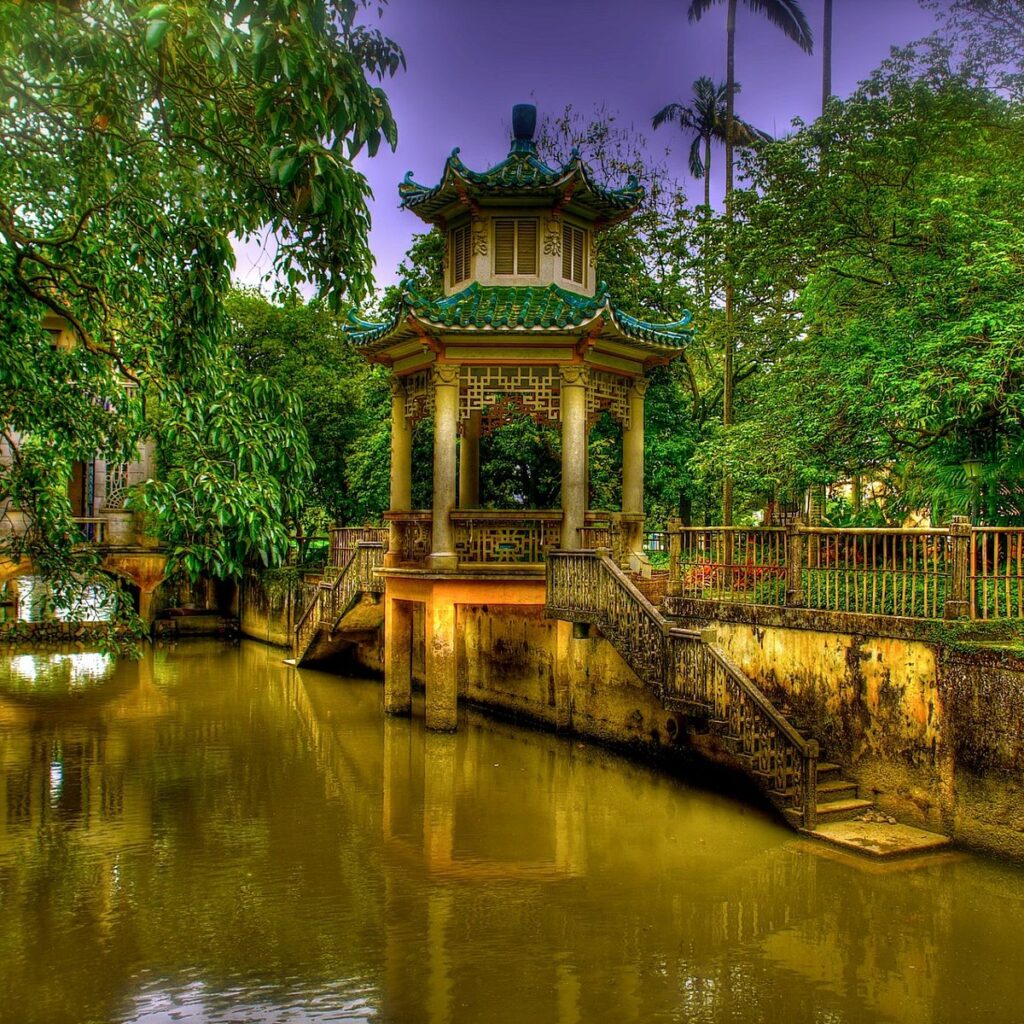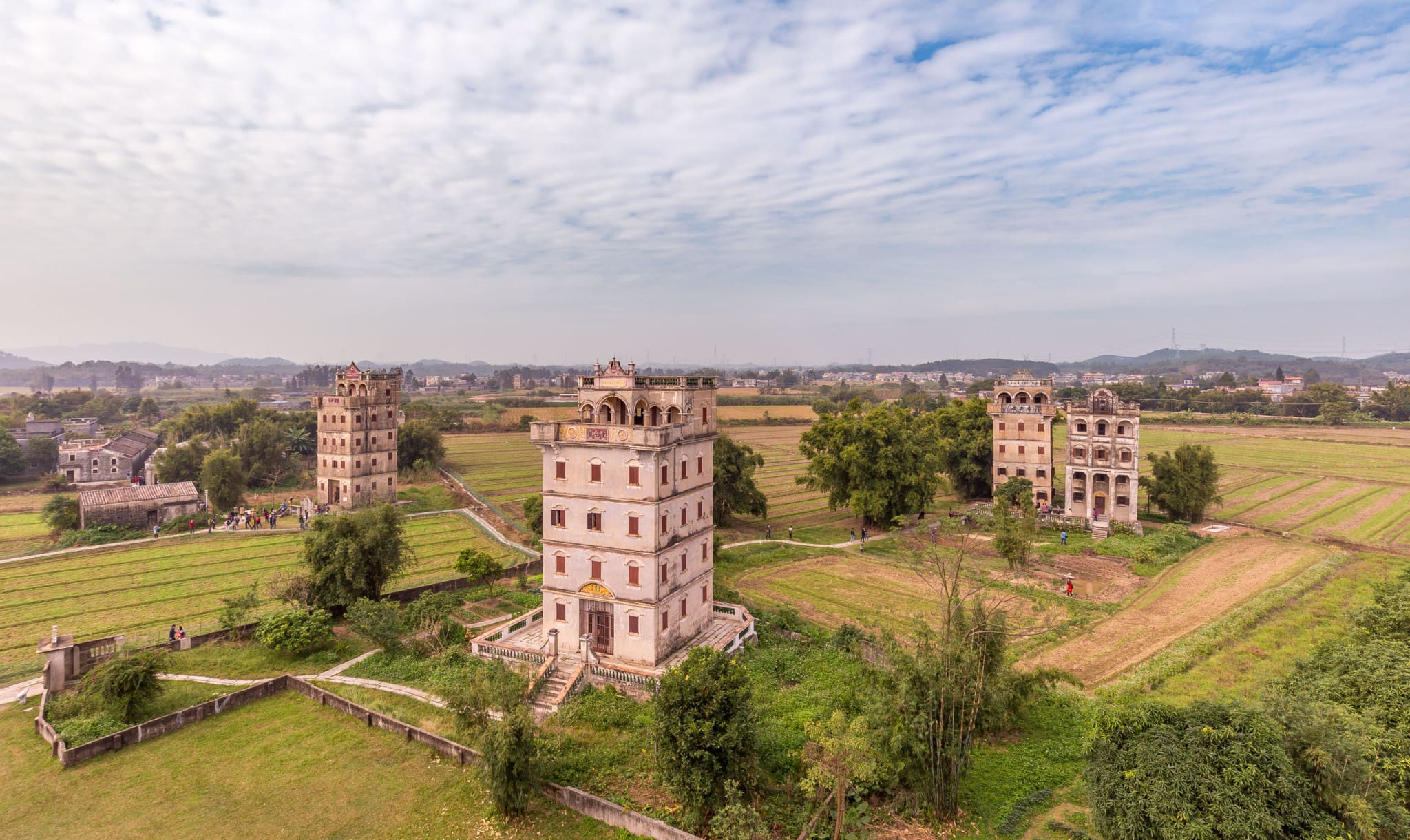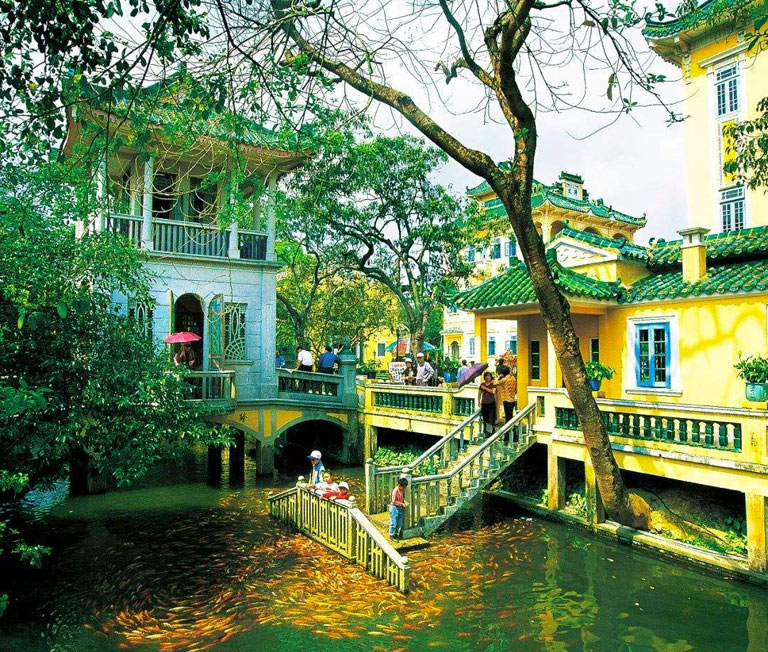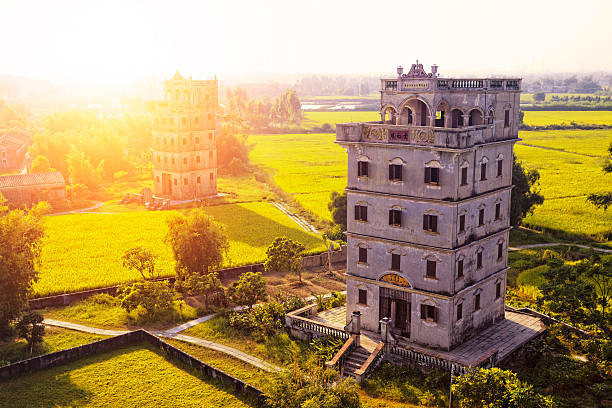Why Kaiping Diaolou Should Be Your Next Travel Destination

An Essential Guide to Visiting Kaiping Diaolou And Villages
Nestled in the heart of Guangdong province, Kaiping Diaolou and Villages unfold a captivating tapestry of history, culture, and stunning architecture. Recognized as a UNESCO World Heritage site, this enchanting destination boasts an array of unique watchtowers known as diaolou, which stand as fortifications from the turbulent 17th century. These multi-story structures, a remarkable blend of traditional Chinese and Western architectural styles, tell a story of a bygone era, when local residents sought both beauty and protection amid societal challenges.
As you wander through the serene countryside, the picturesque villages of Zili, Majianglong, and Li Garden beckon with their well-preserved charm. Each village is a delightful showcase of colorful buildings and lush landscapes, inviting visitors to delve into the rich cultural heritage of the area. Whether you are an architecture enthusiast, a history buff, or simply an adventurous traveler, the Kaiping Diaolou offers a unique glimpse into a time when practical design met artistic expression.
With its tranquil ambiance and captivating scenery, Kaiping is not just a destination; it’s an exploration of the resilience and creativity of its people. From the breathtaking views atop the lofty towers to the quaint streets lined with local shops and eateries, this journey promises to be a memorable experience that will linger long after you’ve left. Join us as we uncover the secrets and stories of Kaiping Diaolou and its enchanting villages, a true hidden gem waiting to be discovered.
In This Guide
- An Essential Guide to Visiting Kaiping Diaolou And Villages
- The Rich History and Legends of Kaiping Diaolou And Villages
- Main Highlights: What You Absolutely Can’t Miss
- Planning Your Visit: A Practical Guide
- Tickets: Prices, Booking, and Tips
- How to Get There: A Complete Transportation Guide
- Local Cuisine and Accommodation Nearby
- Frequently Asked Questions
- Final Thoughts on Your Trip
The Rich History and Legends of Kaiping Diaolou And Villages
Nestled in the heart of Guangdong Province, the Kaiping Diaolou and Villages are a remarkable testament to the region’s rich history and cultural tapestry. These iconic watchtowers, known as Diaolou, serve not only as architectural marvels but also as historical markers, reflecting the unique blend of Chinese and Western influences that emerged in the late Ming and Qing dynasties.
The construction of the Diaolou began in the 17th century, primarily as a response to the threat of banditry in the area. Wealthy families, many of whom had emigrated overseas in search of better fortunes, returned to invest in their ancestral homelands. They built these multi-story structures as both residences and fortifications, characterized by their distinctive architectural styles that fuse traditional Chinese designs with Western elements. This eclectic mix is particularly evident in the ornate details and materials used, showcasing a creative response to both functionality and aesthetics.
By the early 20th century, the Diaolou had become symbols of prosperity and protection. Approximately 1,800 of these towers were constructed across the region, with around 500 still standing today, each telling its own story of the families that once resided within their walls. The most famous clusters, such as those in Zili Village and Majianglong, have been recognized as UNESCO World Heritage Sites, drawing visitors from around the globe eager to explore their historical significance and architectural beauty.
In addition to their defensive purpose, the Diaolou are deeply embedded in local legends and folklore. Stories of bravery, family loyalty, and the struggles of the past are often recounted by local guides, adding a layer of mystique to the already enchanting landscape. These narratives not only enrich the visitor experience but also serve to preserve the memories of the ancestors who built these towers.
A visit to the Kaiping Diaolou and Villages provides a unique opportunity to step back in time. As you wander through the lush countryside, where rice paddies and traditional farming coexist with these towering structures, you can almost hear the echoes of history. The tranquility of the villages, combined with the impressive architecture, offers a glimpse into a lifestyle that, while evolving, remains deeply rooted in tradition.
Whether you are an architecture enthusiast, a history buff, or simply seeking a picturesque escape, the Kaiping Diaolou and Villages promise an unforgettable journey through time. Each tower stands as a silent sentinel of the past, inviting you to explore the rich history and legends that continue to shape this remarkable region.

Kaiping Diaolou And Villages.
Main Highlights: What You Absolutely Can’t Miss
Exploring Kaiping Diaolou and Villages is like stepping into a living museum, where history and architecture intertwine to create a breathtaking experience. As you traverse this UNESCO World Heritage site, here are the key highlights that you absolutely can’t miss:
1. The Iconic Diaolou Towers
The centerpiece of your visit will undoubtedly be the iconic Diaolou, multi-story watchtowers built between the 17th and 20th centuries. These unique structures blend Chinese and Western architectural styles, originally constructed for defense against bandits. Notable clusters include Zili Village, Majianglong, and Li Garden, each showcasing stunning towers that tell the stories of their eras. Climbing to the top of these towers rewards you with breathtaking views of the flat countryside, allowing you to appreciate the historical landscape.
2. Zili Village
Among the many villages, Zili Village stands out as a must-visit. It boasts some of the most well-preserved Diaolou and offers a picturesque setting with a scenic pond and charming wooden walkways. The Yinonglu Villa, a six-level structure, is particularly impressive, providing insight into the opulent lifestyle of its original inhabitants. The combination of greenery and historical architecture makes Zili a photographer’s paradise.
3. Chikan European Style Street
Just a short trip from the Diaolou, Chikan European Style Street offers a delightful contrast. This area is known for its unique blend of European architecture and traditional Chinese elements. Stroll along the cobbled streets lined with boutique shops and cafes, where you can take a break and enjoy some local delicacies. It’s a perfect spot for those looking to immerse themselves in the cultural fusion of the region.
4. Majianglong Village
Another gem is Majianglong Village, renowned for its less touristy atmosphere yet equally stunning architecture. Here, you can explore several well-preserved Diaolou that are less frequented, giving you a more intimate experience. Take a leisurely walk through the village to appreciate its rural charm and the everyday lives of its residents.
5. Kaiping Garden
After exploring the Diaolou, take a moment to relax at the Kaiping Garden. This serene space is a beautiful blend of classical Chinese garden design with stunning landscapes, ponds, and traditional pavilions. It’s an excellent spot to unwind and reflect on the rich history you’ve encountered.
6. Cultural Insights and Local Cuisine
No visit is complete without indulging in the local cuisine. Stop at one of the village eateries or the Li Garden Village visitor’s center, where you can sample traditional dishes made with local ingredients. This culinary experience adds another layer to your understanding of the region’s culture and heritage.
7. Guided Tours
For a deeper dive into the history and significance of the Diaolou, consider joining a guided tour. Many options are available, ranging from private day trips to multi-day excursions from major nearby cities like Guangzhou. These tours often include visits to multiple villages, providing a comprehensive overview of the area’s rich cultural tapestry.
8. Scenic Walks and Photography Opportunities
The flat landscape surrounding the villages offers endless opportunities for scenic walks. Don’t forget your camera! The juxtaposition of the Diaolou against the expansive rural backdrop makes for stunning photographs at every turn.
Conclusion
A visit to Kaiping Diaolou and Villages is not just an exploration of unique architecture; it’s a journey through time. Each tower and village holds stories waiting to be uncovered. Whether you’re an architecture enthusiast, a history buff, or simply a curious traveler, the Kaiping Diaolou promises an unforgettable experience that celebrates the beauty of cultural heritage.

Kaiping Diaolou And Villages.
Planning Your Visit: A Practical Guide
Visiting the Kaiping Diaolou and Villages offers a unique glimpse into China’s architectural heritage, coupled with breathtaking landscapes and rich history. This guide will help you plan your visit, ensuring you make the most of your time in this UNESCO World Heritage site.
Getting There
Location
Kaiping is located approximately 100 kilometers (about 62 miles) from Guangzhou, making it easily accessible for day trips. The region is well-connected by public transportation, including buses and private tours. If you prefer to drive, rental cars are available, and the roads are relatively straightforward.
Transportation Options
– By Bus: Regular buses run from Guangzhou to Kaiping, with several departures throughout the day. The journey typically takes around two hours.
– By Train: You can take a train to Jiangmen and then transfer to a bus or taxi to reach Kaiping.
– Private Tours: Many visitors opt for guided tours, which often include transportation, entrance fees, and knowledgeable guides who provide insights into the history and architecture of the diaolou.
Best Time to Visit
The ideal time to explore Kaiping Diaolou is during the spring (March to May) and autumn (September to November) when the weather is mild and pleasant. Summers can be hot and humid, while winters are cool but generally dry. If possible, try to visit on weekdays to avoid larger crowds, especially in popular tourist areas.
Opening Hours
The Kaiping Diaolou and Villages are open daily from 8:30 AM to 5:30 PM. Plan your visit accordingly to ensure you have ample time to explore the various sites without feeling rushed.
Ticket Information
Entrance tickets can be purchased at the visitor centers, such as the Li Garden Village. Tickets typically cover access to multiple villages, including Zili and Majianlong, and range from $10 to $15 depending on the package. Consider booking a guided tour for a more in-depth experience, as many tours include all entrance fees and meals.
Must-See Attractions
-
Zili Village: Known for its stunning diaolou towers, this village is a picturesque spot to admire the unique architecture that blends Chinese and Western styles. Don’t miss the Yinonglu Villa, the tallest structure in the area, which offers panoramic views from its top.
-
Majianlong Village: This area is less touristy, providing an authentic feel of rural life. Stroll through the village to experience the local culture and see the well-preserved buildings.
-
Chikan Town: An excellent place for a leisurely walk, Chikan features European-style streets lined with shops and cafes. It’s a great spot to grab a meal or a coffee while soaking in the atmosphere.
Tips for Your Visit
-
Wear Comfortable Shoes: The terrain can be uneven, and you’ll likely be doing a fair amount of walking, especially if you plan to explore multiple villages.
-
Stay Hydrated: Bring water with you, especially if you’re visiting during the warmer months.
-
Photography: The diaolou and surrounding landscapes provide incredible photo opportunities. Don’t forget your camera!
-
Local Cuisine: Take a break and enjoy the local delicacies at one of the village restaurants. Dishes often feature fresh, locally sourced ingredients.
-
Explore the Countryside: If time permits, take a leisurely walk through the surrounding countryside to appreciate the natural beauty and rural life.
Accommodation Options
If you wish to extend your stay, Kaiping offers a range of accommodations, from budget hostels to mid-range hotels. Booking in advance during peak seasons is advisable to secure your preferred lodging.
Final Thoughts
A visit to the Kaiping Diaolou and Villages is not just a trip to see historical structures; it’s an immersion into the rich tapestry of cultural heritage and the stories of those who lived in these unique towers. With proper planning, your journey to this remarkable destination will be both enlightening and unforgettable!

Kaiping Diaolou And Villages.
Tickets: Prices, Booking, and Tips
Visiting the Kaiping Diaolou and Villages is an unforgettable experience that combines history, architecture, and stunning landscapes. To make the most of your visit, here’s everything you need to know about ticket prices, booking options, and helpful tips.
Ticket Prices
Access to the Kaiping Diaolou and Villages typically requires a ticket that grants entry to multiple sites within the area. Here’s a general breakdown of the costs:
- Standard Admission: Tickets usually range from ¥80 to ¥100 (approximately $12 to $15) per person. This price often includes access to several diaolou sites, such as Zili, Li Garden, and Majianglong.
- Guided Tours: If you prefer a more structured experience, consider booking a guided tour. Prices for private day tours from Guangzhou can range from $200 to $584, depending on the length and inclusivity of the tour.
Booking Options
-
Online Reservations: Many travelers find it convenient to book tickets in advance through platforms such as TripAdvisor, Klook, or Viator. These platforms often offer various tour packages, including transportation, meals, and guided services.
-
On-Site Purchase: If you prefer spontaneity, tickets can be purchased at the visitor center located at the Li Garden Village. It’s advisable to arrive early, especially during peak tourist seasons, to avoid long queues.
-
Group Discounts: If you’re traveling with a large group, inquire about group discounts when booking your tickets. Many tour operators offer reduced rates for groups.
Tips for Your Visit
-
Plan Your Day: Allocate at least three to five hours to explore the area thoroughly. The diaolou are spread out, and you’ll want to take your time to appreciate the unique architecture and landscapes.
-
Transportation: Consider renting a bicycle or using the local bus service to hop between the villages. This can enhance your experience and give you a taste of rural life.
-
Check Opening Hours: The sites typically operate from 8:30 AM to 5:30 PM, so plan your visit accordingly. Arriving early can help you avoid crowds and enjoy a more peaceful experience.
-
Cultural Etiquette: Respect the local customs and the residents, as many of these villages are still inhabited. Be mindful of taking photos, especially indoors or of people, and always ask for permission when in doubt.
-
Bring Cash: While many tourist spots accept cards, having some cash on hand can be useful, especially in smaller shops or food stalls.
By following these guidelines, you can ensure a memorable and hassle-free visit to the enchanting Kaiping Diaolou and Villages. Enjoy your exploration of this UNESCO World Heritage site, where history and stunning architecture await!
How to Get There: A Complete Transportation Guide
Reaching the remarkable Kaiping Diaolou and Villages, a UNESCO World Heritage site, is an adventure in itself. This breathtaking destination, known for its unique watchtowers and rich history, is easily accessible from major cities in southern China. Here’s a comprehensive guide to help you navigate your way to this architectural gem.
From Guangzhou
By Train
– Duration: Approximately 1.5 to 2 hours
– Details: High-speed trains from Guangzhou South Station to Kaiping Railway Station are your best option. Trains run frequently throughout the day, making it convenient for day trips. Once you arrive at Kaiping Railway Station, you can take a taxi or local bus to the Diaolou and Villages.
By Bus
– Duration: About 2 to 2.5 hours
– Details: Buses from Guangzhou’s Provincial Bus Station or Tianhe Bus Station head directly to Kaiping. This is a cost-effective choice, with buses operating regularly. The bus will drop you off in the city, from where you can take a taxi or local transport to the diaolou sites.
By Private Car
– Duration: Approximately 1.5 hours
– Details: Renting a car or hiring a driver can provide a more personalized experience. Follow the G15 highway, and enjoy the scenic views along the way. This option is especially convenient if you plan to visit multiple villages.
From Shenzhen
By Train
– Duration: Approximately 2 to 2.5 hours
– Details: Take a train from Shenzhen to Kaiping. Similar to the journey from Guangzhou, this involves a transfer at Guangzhou South Station. The train ride offers a comfortable and fast solution to reach Kaiping.
By Bus
– Duration: About 3 to 4 hours
– Details: Direct buses from Shenzhen to Kaiping are available, departing from various bus stations. This is a budget-friendly option, although it may take a bit longer than train travel.
Local Transportation in Kaiping
Once in Kaiping, there are several efficient ways to explore the diaolou and surrounding villages:
Local Buses
– Kaiping has a network of buses that connect the major diaolou sites, including Zili Village, Li Garden, and Majianglong. These buses are economical and run regularly.
Bicycles and Electric Scooters
– For a more leisurely exploration, consider renting a bicycle or an electric scooter. This allows you to enjoy the picturesque countryside at your own pace.
Taxis and Ride-Sharing
– Taxis are readily available in Kaiping, and ride-sharing apps may also operate in the area. This is a convenient way to travel between villages or return to your accommodation after a day of exploration.
Tips for a Smooth Journey
- Plan Ahead: Check train and bus schedules in advance, especially during peak tourist seasons.
- Language Assistance: While many signs are in English, having a translation app or phrasebook can be helpful, as English is not widely spoken in the region.
- Local Cuisine: Don’t miss the opportunity to enjoy local delicacies at the visitor centers, such as the Li Garden Village, where you can also buy tickets for the various villages.
By following this transportation guide, you’ll be well on your way to experiencing the stunning architecture and captivating history of the Kaiping Diaolou and Villages. Safe travels!

Kaiping Diaolou And Villages.
Local Cuisine and Accommodation Nearby
When visiting the captivating Kaiping Diaolou and Villages, indulging in the local cuisine and finding comfortable accommodation nearby can greatly enhance your experience. Here are some recommendations to ensure your trip is both delicious and restful.
Dining Delights
-
Li Garden Restaurant (李园餐厅)
Located near the Li Garden Village visitor center, this restaurant is a popular stop for travelers. The menu features traditional Cantonese dishes, including fresh seafood and local specialties. Enjoy a hearty meal before or after exploring the diaolou, and take advantage of the beautiful garden setting. -
Chikan European Style Street Food Stalls
After visiting the diaolou, take a stroll down Chikan European Style Street. Here, you’ll find a variety of food stalls offering quick bites and local delicacies. Sample street food favorites like dim sum, fried rice, and roast meats. The vibrant atmosphere makes it a perfect spot to unwind. -
Majianlong Village Restaurant
Nestled within the charming Majianlong village, this family-run eatery serves authentic home-cooked meals. The menu often features seasonal ingredients sourced from local farms, ensuring freshness in every dish. It’s an excellent place to experience the warmth of local hospitality.
Cozy Accommodations
-
Kaiping Diaolou Hotel
Situated conveniently near the main attractions, this hotel offers comfortable rooms with modern amenities. Guests appreciate the friendly service and the proximity to the diaolou sites. Staying here gives you easy access to the beautiful countryside and historical landmarks. -
Zili Village Guesthouse
For a more immersive experience, consider staying at a guesthouse in Zili Village. These accommodations often reflect the local architecture and provide a unique opportunity to experience village life. Enjoy the peaceful surroundings and warm hospitality of the hosts, who may even share stories about the area’s history. -
Chikan Inn
Located close to Chikan European Style Street, this inn offers a blend of traditional charm and modern comfort. With spacious rooms and a welcoming atmosphere, it’s an ideal base for exploring the nearby attractions. Don’t miss their breakfast, which features a mix of local and Western options.
Tips for Your Visit
- Transportation: There are bus routes connecting the villages, making it easy to explore multiple locations in one day.
- Timing: Plan your meals around your exploration schedule; many restaurants are busy during peak lunch and dinner hours.
- Local Flavors: Don’t hesitate to ask locals for their favorite dining spots or dishes to try. The hospitality in this region is renowned, and many will be eager to share their recommendations.
By savoring the local cuisine and finding the perfect place to rest, your visit to the Kaiping Diaolou and Villages will be a truly enriching experience. Enjoy the flavors and charm of this UNESCO World Heritage site!

Kaiping Diaolou And Villages.
Frequently Asked Questions
Frequently Asked Questions for Your Trip to Kaiping Diaolou and Villages
1. What are the Kaiping Diaolou?
The Kaiping Diaolou are unique multi-story watchtowers built between the 17th and 20th centuries. Originally constructed for defense against bandits, these structures blend Chinese and Western architectural styles, offering a fascinating glimpse into the area’s history. They have been recognized as a UNESCO World Heritage site due to their cultural significance.
2. When is the best time to visit?
The best time to visit Kaiping is during the spring (March to May) and autumn (September to November) months when the weather is mild and pleasant. Avoid the peak of summer due to high temperatures and humidity, as well as the rainy season from June to August.
3. How do I get to Kaiping from Guangzhou?
Kaiping is approximately 100 km (about 62 miles) from Guangzhou. You can take a train or bus from Guangzhou to Kaiping, which typically takes around 2 to 3 hours. Private tours and taxis are also popular options for convenience and comfort.
4. Are there guided tours available?
Yes, there are several guided tour options available, ranging from half-day to multi-day tours. These tours often include visits to the main diaolou sites and provide insights into the history and architecture of the area. Booking in advance is recommended, especially during peak tourist seasons.
5. What should I wear while visiting the Diaolou?
Comfortable footwear is essential as you’ll be walking around the villages and climbing stairs inside the watchtowers. Dress in lightweight, breathable clothing, and consider bringing a hat and sunscreen, especially if you plan to spend ample time outdoors.
6. Is there an entry fee to visit the Diaolou?
Yes, there is an entry fee to visit the various diaolou sites. Prices can vary depending on the specific buildings and villages you wish to explore. Discounts may be available for students and seniors, so be sure to inquire when purchasing tickets.
7. What facilities are available for tourists?
The main visitor centers at Kaiping provide amenities such as restrooms, eateries, and information desks. Additionally, there are bus routes connecting the villages, making it easier to navigate the area. EV charging stations can also be found at some locations.
8. Can I explore the villages on my own?
Absolutely! While guided tours are available, many visitors enjoy exploring the diaolou and surrounding villages at their own pace. Just be sure to check the opening hours of the sites you plan to visit and consider obtaining a map for easier navigation.
Final Thoughts on Your Trip
As you reflect on your journey through the enchanting Kaiping Diaolou and Villages, let the echoes of history and the beauty of architecture linger in your mind. This UNESCO World Heritage site is not just a collection of unique watchtowers; it is a testament to the resilience and creativity of the communities that built them. Each Diaolou tells a story of cultural fusion, blending Chinese and Western influences in a way that is both striking and profound.
Strolling through the picturesque landscapes, you have had the chance to connect with the rural charm of Kaiping, witnessing daily life unfold amidst these architectural gems. The serene countryside, dotted with vibrant villages, offers a glimpse into a past that is still very much alive. Whether you marveled at the intricate designs of the towers, savored delicious local cuisine, or simply soaked in the peaceful ambiance, this experience is one that enriches your understanding of China’s diverse heritage.
As you return home, carry with you the memories of the captivating views from the rooftops, the stories shared by locals, and the timeless beauty of the Kaiping Diaolou. This journey is not just a visit; it is an invitation to explore deeper narratives that connect us across cultures and generations. So, until your next adventure, may the spirit of Kaiping inspire you to seek out the extraordinary in every corner of the world. Safe travels!